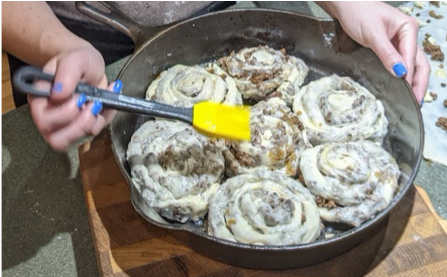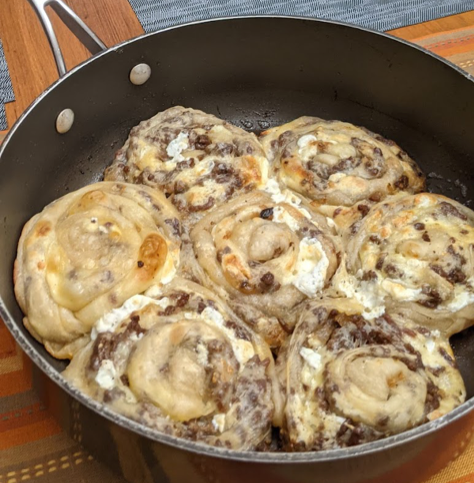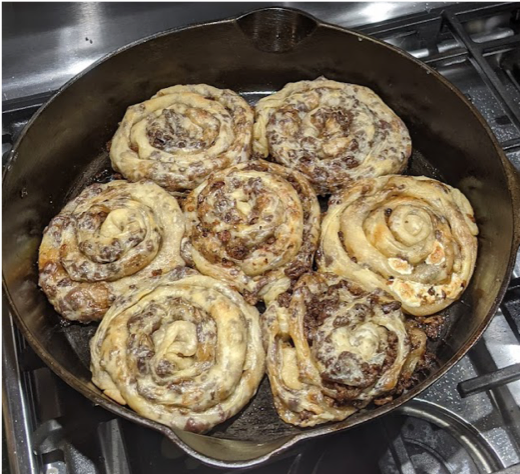Baking Burek in Virginia
First attempts at preparing and sharing a Balkan pastry at home
“Bureki” are a traditional pastry in Balkan countries, Balkan Language Student, Michelle Jones made them with family in the USA
One of my first introductions to local, widely known food in the Balkans began with a spiraled pastry stuffed with ground meat called Burek (pronounced “boor-yek”) from a buregdžinica, which is a specialized shop similar to a bakery that prepares Burek. I was on a trip to a hiking trail that follows a former Austro-Hungarian road overlooking Kotor Bay, when my hiking buddies decided it was time for my first experience with burek. We picked up a few individual pastries from one of their favorite shops, packed them into our hiking bags and took off on a journey.
When we reached the peak, after soaking in the view and taking a much-needed breath, we unpacked our snack and I finally got a chance to experience the flaky, oily, and savory pastry so many people have told me about. It was very filling and a heartier food than I was expecting. Definitely provided me with enough energy to reach the bottom of the trail before sunset.
Instead of a hiking snack, Burek is more often eaten as a breakfast food, usually paired with thin yogurt as a drink. It is also a favorite weekend combination when my friends are craving a savory and greasy treat. I have tried Burek of all different shapes and sizes. Some are prepared as large spiraling pies (equivalent to the size of a pizza) that can be sliced into wedges and served. Some are prepared as a layered baked pie, cut into square pieces. And others can be small, individual spiraled pies – which is what I come across most often. One of my first introductions to local, widely known food in the Balkans began with a spiraled pastry stuffed with ground meat called Burek (pronounced “boor-yek”) from a buregdžinica, which is a specialized shop similar to a bakery that prepares Burek. I was on a trip to a hiking trail that follows a former Austro-Hungarian road overlooking Kotor Bay, when my hiking buddies decided it was time for my first experience with burek. We picked up a few individual pastries from one of their favorite shops, packed them into our hiking bags and took off on a journey.
When we reached the peak, after soaking in the view and taking a much-needed breath, we unpacked our snack and I finally got a chance to experience the flaky, oily, and savory pastry so many people have told me about. It was very filling and a heartier food than I was expecting. Definitely provided me with enough energy to reach the bottom of the trail before sunset.
Instead of a hiking snack, Burek is more often eaten as a breakfast food, usually paired with thin yogurt as a drink. It is also a favorite weekend combination when my friends are craving a savory and greasy treat. I have tried Burek of all different shapes and sizes. Some are prepared as large spiraling pies (equivalent to the size of a pizza) that can be sliced into wedges and served. Some are prepared as a layered baked pie, cut into square pieces. And others can be small, individual spiraled pies – which is what I come across most often.
Dough preparations with my dad, a super sourdough bread baker (and baklava!), up to learning something new.
The traditional name varies depending on the contents of the filling. I have learned that the actual name Burek is for pita (thin, flaky pie) containing cooked ground meat, and sometimes onions. Sirnica is a pita with a cottage cheese/ cheese curd filling (sir is the word for cheese), zeljanica is spinach (or other leafy green vegetables) and cheese, and krompiruša has a potato filling. However, I do hear the word Burek used as a collective name.
While attending the last few weeks of online BLI courses in my hometown of Smithfield, Virginia, I found myself missing some of the comforting flavors from the Balkans and decided to attempt to make Burek with my family. I asked friends from Podgorica, Montenegro for family recipes, watched video tutorials online, and read a few online recipes recommended from the cultural activity director from BLI.
After researching quite a few methods and recipes, I tried to piece together a formula that I thought would best imitate the Burek at my favorite shop in Podgorica called Ambasada Zabjelo. I decided to stay true with a meat filling, but I also added finely chopped onions and mushrooms to the mix to try to create something similar to their recipe. The rest of the ingredients for making Burek are usually staples in the kitchen, making it a convenient and inexpensive dish to prepare, just a bit labor intensive.
To begin, we could have purchased already prepared phyllo dough from a grocery store; however, I was up for a challenge and wanted to make the dough from scratch. The dough included flour, salt, and warm water, kneaded into small balls and later dipped into a melted butter and oil spread.
After time to soak in the butter and oil, the small bundles of dough were rolled out into flat, circular shaped layers. More oil and butter was brushed onto the flatted sheets, and they were left to rest while the filling was prepared. In a pan, I sauteed the ground beef with salt, pepper, and paprika, and later tossed in a little garlic, onion powder, plus a pinch of cumin to try to see if that flavor would match the taste of the Ambasada Zabjelo Burek. While the meat was cooling, we cooked the onions and mushrooms.
Then the real operation began. We spread out the first dough sheet across a clean countertop.
Spreading the meat and mushroom mixture across the pastry and trying our best to roll it up
The dough was very thin and delicate but we managed to stretch it into a large rectangular shape with only a few little tears. Then we sprinkled our mixtures across the dough and started what felt like the most difficult yet enjoyable step – rolling the dough with as few rips in the pastry as possible and placing our spirals gently into an over safe pan. We also prepared our version of Srinica, with a filling of large curd cottage cheese, small mozzarella cubes found in the refrigerator, and egg. After some impatient glances in the oven, our pastries were finally sizzling and starting to gain color. It was time to share a little flavor of the Balkans with my family.
We enjoyed our Burek with plain yogurt as per tradition; however, when I usually enjoy this dish, I commit what might be a Burek eating crime and prefer to dip it in yogurt instead of drinking the yogurt. The flavors turned out really nicely, similar to some of my favorite pies, but the pastry was not as flaky as usual. However, even my grandfather, who can be a pretty picky eater, approved. Additionally, the leftovers made a nice breakfast the next day.
My recreation of Balkan Burek served as a chance to spend an evening covered in flour and dough bits while sharing stories of my experiences in Montenegro and other countries in the region. In the background, we played a playlist filled with over one hundred local songs a friend from Podgorica made for me. Despite the long preparation, I think everyone felt that the experience, and the food, was worth the effort. We enjoyed our Burek with plain yogurt as per tradition; however, when I usually enjoy this dish, I commit what might be a Burek eating crime and prefer to dip it in yogurt instead of drinking the yogurt. The flavors turned our really nicely, similar to one of my favorite pies, but the pastry was not as flaky as usual. However, even my grandfather, who can be a pretty picky eater, approved. Additionally, the leftovers made a nice breakfast the next day. My recreation of Balkan Burek served as a chance to spend an evening covered in flour and dough bits while sharing stories of my experiences in Montenegro and other countries in the region. In the background, we played a playlist filled with over one hundred local songs a friend from Podgorica made for me. Despite the long preparation, I think everyone felt that the experience, and the food, was worth the effort.
I will make Burek again – especially with the hopes of experimenting with fillings and flavors; however, before I get too carried away, I would like to learn directly from the many great cooks I have met in Montenegro. A video or recipe online could never replace the tips and tricks picked up from many years of experience and generations of family preparation. Also, there is something about long cooking processes that bring out some of the best conversations I’ve had with people. I’m looking forward to returning to the region, next time with more practice speaking the language, to be able to learn how to prepare Burek and other traditional dishes.







